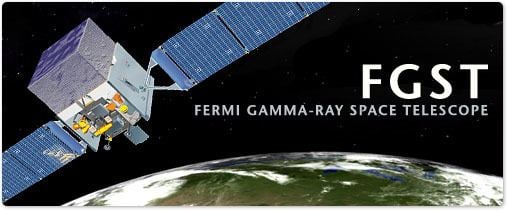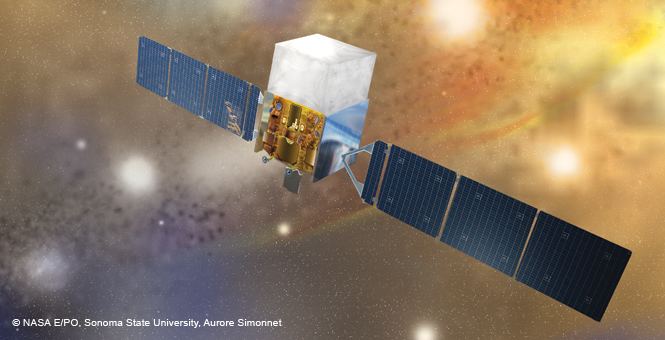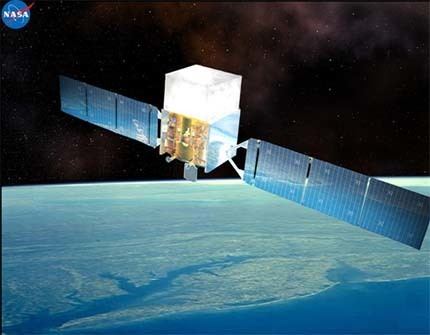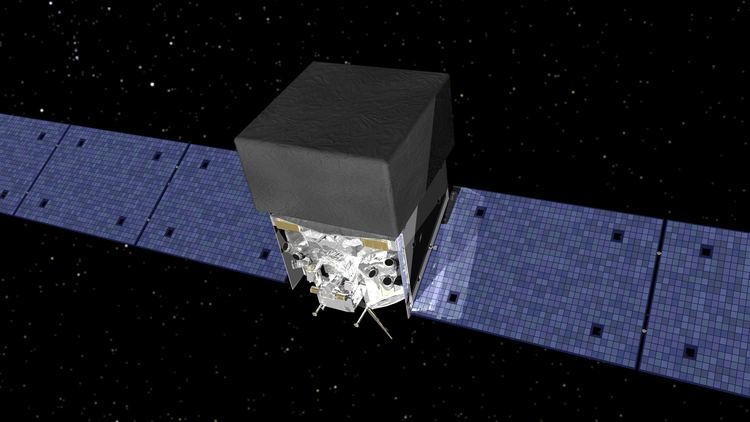Mission type Gamma-ray observatory SATCAT no. 33053 Inclination 25.58° Period 1.6 hours Launch mass 4,303 kg | COSPAR ID 2008-029A Launch date 11 June 2008 Inclination 25.58° Launch mass 4,303 kg | |
 | ||
Names Gamma-ray Large Area Space Telescope Similar Compton Gamma Ray Obse, Chandra X‑ray Observatory, AGILE, XMM‑Newton, Suzaku | ||
The Fermi Gamma-ray Space Telescope (FGST), formerly called the Gamma-ray Large Area Space Telescope (GLAST), is a space observatory being used to perform gamma-ray astronomy observations from low Earth orbit. Its main instrument is the Large Area Telescope (LAT), with which astronomers mostly intend to perform an all-sky survey studying astrophysical and cosmological phenomena such as active galactic nuclei, pulsars, other high-energy sources and dark matter. Another instrument aboard Fermi, the Gamma-ray Burst Monitor (GBM; formerly GLAST Burst Monitor), is being used to study gamma-ray bursts.
Contents
- Overview
- GLAST renamed Fermi Gamma ray Space Telescope
- Mission
- Prelaunch
- Launch
- Orbit
- Software modifications
- LATGBM computers operational
- Sky survey mode
- Collision avoided
- Extended mission 2013 2018
- Pulsar discovery
- Greatest GRB energy release
- Cosmic rays and supernova remnants
- Background gamma ray sources
- Milky Way GammaX ray bubbles
- Highest energy light ever seen from the Sun
- Terrestrial gamma ray flash observations
- GRB 130427A
- GRB coincident with gravitational wave event
- Gamma ray Burst Monitor
- Large Area Telescope
- Education and public outreach
- Rossi Prize
- References

Fermi was launched on 11 June 2008 at 16:05 UTC aboard a Delta II 7920-H rocket. The mission is a joint venture of NASA, the United States Department of Energy, and government agencies in France, Germany, Italy, Japan, and Sweden.

Overview
Fermi includes two scientific instruments, the Large Area Telescope (LAT) and the Gamma-ray Burst Monitor (GBM).


General Dynamics Advanced Information Systems (formerly Spectrum Astro and now Orbital Sciences) in Gilbert, Arizona designed and built the spacecraft that carries the instruments. It travels in a low, circular orbit with a period of about 95 minutes. Its normal mode of operation maintains its orientation so that the instruments will look away from the Earth, with a "rocking" motion to equalize the coverage of the sky. The view of the instruments will sweep out across most of the sky about 16 times per day. The spacecraft can also maintain an orientation that points to a chosen target.

Both science instruments underwent environmental testing, including vibration, vacuum, and high and low temperatures to ensure that they can withstand the stresses of launch and continue to operate in space. They were integrated with the spacecraft at the General Dynamics ASCENT facility in Gilbert, Arizona.

Data from the instruments are available to the public through the Fermi Science Support Center web site. Software for analyzing the data is also available.
GLAST renamed Fermi Gamma-ray Space Telescope
Fermi gained its new name in 2008: On 26 August 2008, GLAST was renamed the "Fermi Gamma-ray Space Telescope" in honor of Enrico Fermi, a pioneer in high-energy physics.
NASA's Alan Stern, associate administrator for Science at NASA Headquarters, launched a public competition 7 February 2008, closing 31 March 2008, to rename GLAST in a way that would "capture the excitement of GLAST's mission and call attention to gamma-ray and high-energy astronomy ... something memorable to commemorate this spectacular new astronomy mission ... a name that is catchy, easy to say and will help make the satellite and its mission a topic of dinner table and classroom discussion".
Mission
NASA designed the mission with a five-year lifetime, with a goal of ten years of operations.
The key scientific objectives of the Fermi mission have been described as:
The National Academies of Sciences ranked this mission as a top priority. Many new possibilities and discoveries are anticipated to emerge from this single mission and greatly expand our view of the Universe. (The following list is abbreviated as discoveries are made. To read about discoveries already made, see "Discoveries" below.)
Prelaunch
On 4 March 2008, the spacecraft arrived at the Astrotech payload processing facility in Titusville, Florida. On 4 June 2008, after several previous delays, launch status was retargeted for 11 June at the earliest, the last delays resulting from the need to replace the Flight Termination System batteries. The launch window extended from 15:45 to 17:40 UTC daily, until 7 August 2008.
Launch
Launch occurred successfully on 11 June 2008 at 16:05 UTC aboard a Delta 7920H-10C rocket from Cape Canaveral Air Force Station Space Launch Complex 17-B. Spacecraft separation took place about 75 minutes after launch.
Orbit
Fermi resides in a low-Earth circular orbit at an altitude of 550 km (340 mi), and at an inclination of 28.5 degrees.
Software modifications
GLAST received some minor modifications to its computer software on 23 June 2008.
LAT/GBM computers operational
Computers operating both the LAT and GBM and most of the LAT's components were turned on 24 June 2008. The LAT high voltage was turned on 25 June, and it began detecting high-energy particles from space, but minor adjustments were still needed to calibrate the instrument. The GBM high voltage was also turned on 25 June, but the GBM still required one more week of testing/calibrations before searching for gamma-ray bursts.
Sky survey mode
After presenting an overview of the Fermi instrumentation and goals, Jennifer Carson of SLAC National Accelerator Laboratory had concluded that the primary goals were "all achievable with the all-sky scanning mode of observing". Fermi switched to "sky survey mode" on 26 June 2008 so as to begin sweeping its field of view over the entire sky every three hours (every two orbits).
Collision avoided
On 30 April 2013, NASA revealed that the telescope had narrowly avoided a collision a year earlier with a defunct Cold War-era Soviet spy satellite, Kosmos 1805, in April 2012. Orbital predictions several days earlier indicated that the two satellites were expected to occupy the same point in space within 30 milliseconds of each other. On 3 April, telescope operators decided to stow the satellite's high-gain parabolic antenna, rotate the solar panels out of the way and to fire Fermi's rocket thrusters for one second to move it out of the way. Even though the thrusters had been idle since the telescope had been placed in orbit nearly five years earlier, they worked correctly and potential disaster was thus avoided.
Extended mission 2013-2018
In August 2013 Fermi started its 5-year mission extension.
Pulsar discovery
The first major discovery came when the space telescope detected a pulsar in the CTA 1 supernova remnant that appeared to emit radiation in the gamma ray bands only, a first for its kind. This new pulsar sweeps the Earth every 316.86 milliseconds and is about 4,600 light years away.
Greatest GRB energy release
In September 2008, the gamma-ray burst GRB 080916C in the constellation Carina was recorded by the Fermi telescope. This burst is notable as having “the largest apparent energy release yet measured”. The explosion had the power of about 9,000 ordinary supernovae, and the relativistic jet of material ejected in the blast must have moved at a minimum of 99.9999% the speed of light. Overall, GRB 080916C had "the greatest total energy, the fastest motions, and the highest-energy initial emissions" ever seen.
Cosmic rays and supernova remnants
In February 2010, it was announced that Fermi-LAT had determined that supernova remnants act as enormous accelerators for cosmic particles. This determination fulfills one of the stated missions for this project.
Background gamma ray sources
In March 2010 it was announced that active galactic nuclei are not responsible for most gamma-ray background radiation. Though active galactic nuclei do produce some of the gamma-ray radiation detected here on Earth, less than 30% originates from these sources. The search now is to locate the sources for the remaining 70% or so of all gamma-rays detected. Possibilities include star forming galaxies, galactic mergers, and yet-to-be explained dark matter interactions.
Milky Way Gamma/X-ray bubbles
In November 2010, it was announced two gamma-ray and X-ray bubbles were detected around Earth's galaxy, the Milky Way. The bubbles, named Fermi Bubbles, extend about 25 thousand light years distant above and below the center of the galaxy. The galaxy's diffuse gamma-ray fog hampered prior observations, but the discovery team led by D. Finkbeiner, building on research by G. Dobler, worked around this problem.
Highest energy light ever seen from the Sun
In early 2012, Fermi/GLAST observed the highest energy light ever seen in a solar eruption.
At the flare's peak, the LAT detected gamma rays with two billion times the energy of visible light, or about four billion electron volts (GeV), easily setting a record for the highest-energy light ever detected during or immediately after a solar flare
Terrestrial gamma-ray flash observations
Fermi telescope has observed and detected numerous terrestrial gamma-ray flashes and discovered that such flashes can produce 100 trillion positrons, far more than scientists had previously expected.
GRB 130427A
On 27 April 2013, Fermi detected GRB 130427A, a gamma-ray burst with one of the highest energy outputs yet recorded. This included detection of a gamma-ray over 94 billion electron volts (GeV). This broke Fermi's previous record detection, by over three times the amount.
GRB coincident with gravitational wave event
Fermi reported that its GBM instrument detected a weak gamma-ray burst above 50 keV, starting 0.4 seconds after the LIGO event and with a positional uncertainty region overlapping that of the LIGO observation. The Fermi team calculated the odds of such an event being the result of a coincidence or noise at 0.22%. However, observations from the INTEGRAL telescope's all-sky SPI-ACS instrument indicated that any energy emission in gamma-rays and hard X-rays from the event was less than one millionth of the energy emitted as gravitational waves, concluding that "this limit excludes the possibility that the event is associated with substantial gamma-ray radiation, directed towards the observer." If the signal observed by the Fermi GBM was genuinely astrophysical, SPI-ACS would have detected it with a significance of 15 sigma above the background. The AGILE space telescope also did not detect a gamma-ray counterpart of the event. A follow-up analysis of the Fermi report by an independent group, released in June 2016, identified statistical flaws in the initial analysis, and concluded that the observation was consistent with a non-event.
Black hole mergers of the type thought to have produced the gravitational wave event are not expected to produce gamma-ray bursts, as stellar-mass black hole binaries are not expected to have large amounts of orbiting matter. Avi Loeb has theorised that if a massive star is rapidly rotating, the centrifugal force produced during its collapse will lead to the formation of a rotating bar that breaks into two dense clumps of matter with a dumbbell configuration that becomes a black hole binary, and at the end of the star's collapse it triggers a gamma-ray burst. Loeb suggests that the 0.4 second delay is the time it took the gamma-ray burst to cross the star, relative to the gravitational waves.
Gamma-ray Burst Monitor
The Gamma-ray Burst Monitor (GBM) (formerly GLAST Burst Monitor) detects sudden flares of gamma-rays produced by gamma ray bursts and solar flares. Its scintillators are on the sides of the spacecraft to view all of the sky which is not blocked by the Earth. The design is optimized for good resolution in time and photon energy.
"Gamma-ray bursts are so bright we can see them from billions of light years away, which means they occurred billions of years ago, and we see them as they looked then," stated Charles Meegan of NASA's Marshall Space Flight Center.
The Gamma-ray Burst Monitor has detected gamma rays from positrons generated in powerful thunderstorms.
Large Area Telescope
The Large Area Telescope (LAT) detects individual gamma rays using technology similar to that used in terrestrial particle accelerators. Photons hit thin metal sheets, converting to electron-positron pairs, via a process known as pair production. These charged particles pass through interleaved layers of silicon microstrip detectors, causing ionization which produce detectable tiny pulses of electric charge. Researchers can combine information from several layers of this tracker to determine the path of the particles. After passing through the tracker, the particles enter the calorimeter, which consists of a stack of caesium iodide scintillator crystals to measure the total energy of the particles. The LAT's field of view is large, about 20% of the sky. The resolution of its images is modest by astronomical standards, a few arc minutes for the highest-energy photons and about 3 degrees at 100 MeV. The LAT is a bigger and better successor to the EGRET instrument on NASA's Compton Gamma Ray Observatory satellite in the 1990s. Several countries produced the components of the LAT, who then sent the components for assembly at SLAC National Accelerator Laboratory. SLAC also hosts the LAT Instrument Science Operations Center, which supports the operation of the LAT during the Fermi mission for the LAT scientific collaboration and for NASA.
Education and public outreach
Education and public outreach are important components of the Fermi project. The main Fermi education and public outreach website at http://glast.sonoma.edu offers gateways to resources for students, educators, scientists, and the public. NASA's Education and Public Outreach (E/PO) group operates the Fermi education and outreach resources at Sonoma State University.
Rossi Prize
The 2011 Bruno Rossi Prize was awarded to Bill Atwood, Peter Michelson and the Fermi LAT team "for enabling, through the development of the Large Area Telescope, new insights into neutron stars, supernova remnants, cosmic rays, binary systems, active galactic nuclei and gamma-ray bursts."
The 2014 prize went to Tracy Slatyer, Douglas Finkeiner and Meng Su "for their discovery, in gamma rays, of the large unanticipated Galactic structure called the Fermi bubbles."
